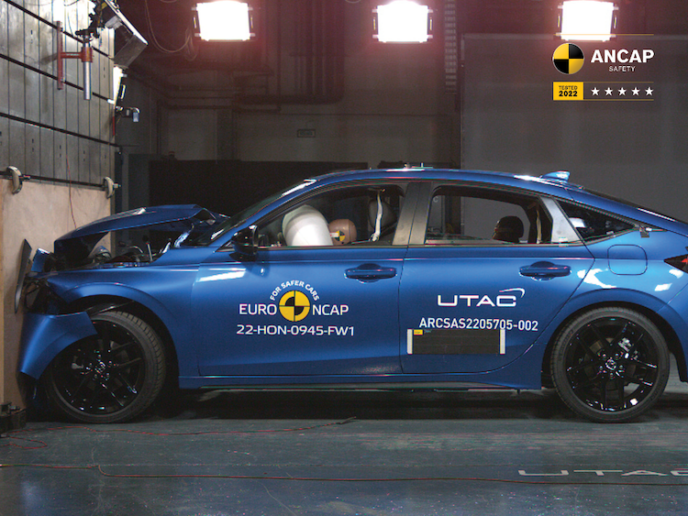
ANCAP Safety has released safety ratings for the Honda CR-V and ZR-V and selected Civic variants.
It is drawing attention to specification differences that can impact the safety of Australian road users.
A five-star ANCAP safety rating for the e: HEV (hybrid) variant of the Honda Civic sold in Australia has been confirmed. This rating remains in line with the five-star safety rating published by ANCAP’s European counterpart, Euro NCAP.
However, the petrol variants of the Honda Civic—which aren’t sold in the European market*—are built to and fitted with considerably different safety specifications from those of its hybrid sibling.
The safety specification differences between hybrid and petrol Honda Civic variants include the omission of:
- centre airbag – which helps protect against occupant-to-occupant and occupant-to-vehicle head injuries for front seat occupants
- side thorax-protecting airbags for rear seat occupants – which help minimise rib and chest injury in side-impact crashes
- speed sign recognition and intelligent speed limiter systems
- intelligent seatbelt reminders for rear seating positions
Because of these differences, ANCAP cannot determine how petrol Civic variants would likely perform when put through rigorous testing, leaving their present status as ‘unrated’.
Honda CR-V vehicles sold in Australia and New Zealand have also been confirmed to hold a different safety specification to their European equivalents. Local CR-V vehicles are sold with a less-sophisticated suite of active collision avoidance (ADAS) features – Honda Sensing rather than the elevated Honda Sensing 360 system – putting the CR-V’s Safety Assist score beneath the five-star threshold at 68%.
In Europe, the Honda CR-V is offered an optional ‘safety pack’, which sees the higher-spec vehicles achieve a five-star rating while those without the safety pack achieve a four-star rating. The higher-performing Honda Sensing 360 system is not offered, even as an option, in vehicles sold to Australian and New Zealand consumers.
For the slightly smaller Honda ZR-V, the four-star rating for European-sold models has been confirmed for Australian models; however, local vehicles are structurally different from their European siblings. A different front bumper beam is fitted to Australian cars, which affects test performance in some test impact locations.
European cars are built with an additional beam in the rear doors, omitted from Australian-sold vehicles. Whilst no observable effect on test performance was identified, Honda has yet to explain why the additional beam has been excluded.
Last month, Euro NCAP published a three-star safety rating for new-generation Suzuki Swift models specified for and sold in the European market. Suzuki Australia has informed ANCAP that the safety specifications of Swift vehicles sold in Australia and New Zealand differ from those sold in Europe. Without testing locally-supplied cars, the safety rating is unknown.
ANCAP is testing the locally supplied Swift to determine its safety performance. Upon completion of local testing, a result will be released.
ANCAP and Euro NCAP took steps in 2018 to align test and rating criteria, encourage uniformity across markets and make it easier for manufacturers to build the same levels of safety into vehicles destined for Australia or Europe.
This alignment enables ANCAP to leverage safety performance results from European testing to publish independent safety ratings for many vehicle models each year, benefitting Australian and New Zealand consumers. ANCAP closely scrutinises each European test result and the specifications of vehicles supplied in Australia and New Zealand to ensure they are relevant and applicable to our local market.
“What we’re seeing here are manufacturers consciously providing Australian and New Zealand consumers with products that do not match the same levels of safety provided to European consumers, and no doubt consumers will be surprised to learn of these differences,” ANCAP chief executive Carla Hoorweg says.
“We are seeing some manufacturers prioritise higher levels of safety only in markets where the regulation requires it – while others offer different safety specifications based on the expectations of dominant sales markets, production locations, or markets with less mature consumer expectations.”
“While we see this occasionally, we don’t want to see a more significant trend emerge,” she says.
Government-enforced safety regulations have recently been enhanced in the European market with the introduction of the EU General Safety Regulation (GSR2), while Australian regulations remain years behind in some areas.
“The lives and safety of Australian and New Zealand consumers are as important as those in Europe or any other world region. That is why we continue to carefully examine new vehicles supplied locally and point out differences so consumers can make informed purchasing decisions,” Hoorweg says.
“Any unrated vehicle is a potential candidate for testing by ANCAP.”
Full rating details are available from the below links:
- Honda Civic e:HEV – http://ancap.link/s/697fff
- Honda CR-V – http://ancap.link/s/0fa4bd
- Honda ZR-V – http://ancap.link/s/1f0c5c
The Honda Civic Type R variant* is sold in some European countries but is unrated for the AUS/NZ and EU markets.








